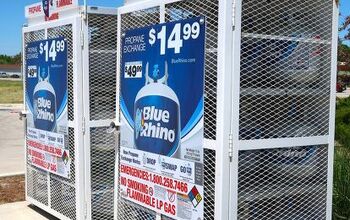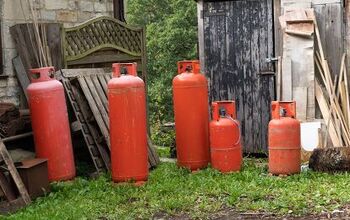Can You Store Propane Tank In The Garage? (Find Out Now!)

Propane gas is known to be one of the safest, easiest, and most reliable sources of fuel. Not only are propane tanks relatively affordable, they are efficient and have a higher-octane rating than gasoline. Though, with propane still being a flammable gas, the concern over safe storage for propane tanks is understandable.
Garages are a convenient place to store tons of items, but are they the ideal location for storing propane tanks? Experts recommend that propane tanks never be stored in garages, or any other indoor location. If the valve on the tank isn’t completely closed, the vapors can escape and concentrate indoors. Instead, propane tanks should always be stored in an outdoor, well-ventilated area.
Although propane cylinders are designed to be incredibly safe and accidents with these tanks are rare, you should still follow safe storage guidelines. With that said, let’s take a deeper look at why you shouldn’t store propane tanks in a garage, and other do’s and don’ts regarding propane tank storage.
Do You Need Water or Fuel Tank Installation or Replacement?
Get free, zero-commitment quotes from pro contractors near you.

Can You Store Propane Tanks in a Garage?
If you’re relatively new to propane tanks, it makes sense to wonder how to properly store them. It’s not uncommon for people to assume that a garage is the perfect location, as many use their garage to store a wide variety of items. So, can you store propane tanks in a garage?
Generally speaking, it’s highly advised that you never store propane tanks in a garage, unless the garage is detached from your home. However, it is still discouraged to do this and the best place to store a propane tank is always outdoors. If a valve on the tank is not closed completely, the vapors inside can escape and begin concentrating indoors.
While accidents are very rare, most of them occur as a result of a valve accidentally being left open. As the gas escapes and can gather near an ignitions source, causing an explosion inside of your garage. Garages are also rarely temperature-controlled and if the temperature inside gets too high, it can create a very dangerous situation for the propane tank.
Where Should Propane Tanks be Stored?
If the garage is not the recommended place to store a propane tank what is? The ideal location for storing a propane tank is outside in a well-ventilation space and on a flat, level surface out of direct sunlight. Place your propane tank on a sturdy surface, such as a slab of concrete or a piece of wood. It’s also important to be aware of other flammable materials nearby and try to keep them at least ten feet away from the tank.
Propane tanks should also never be stored in off-site storage units, as they do not have sufficient ventilation for chemicals or flammable materials. In addition to garages and off-site storage units, you also shouldn’t store propane tanks in basements, tents, cars, and basements.
In the winter when it comes time to put your propane tank away at the end of grilling season, the tank can remain outdoors and will withstand the elements. Ideally, you want to keep the tank underneath your grill’s cover to allow for proper ventilation and keep it protected from snow and ice, which can rust the cylinder. Prior to storage for winter, make sure that you disconnect the tank from the grill and store both the grill and tank in an area that does not experience snow or excessive moisture.
What Temperature Should Propane Tanks Be Stored at?
If a propane tank’s internal temperature gets too high, this can create a deadly situation. With that said, make sure that the location where you store your propane tank never exceeds 120 degrees Fahrenheit. Overall, you should avoid storing a propane tank in any location that will experience high temperatures. So, a shaded outdoor area, away from direct sun exposure, is ideal.
As the temperature outside of a propane tank increases, the temperature and pressure inside the tank also increases. When propane tanks that are exposed to high temperatures for a prolonged period of time, the safety valve will kick in to release and regulate the pressure inside. While this generally prevents explosions, it does cause a slight leak of propane gas which can cause an explosion if the tank is located near an ignition source.
Propane Tank Storage Do’s and Don’ts
While accidents with propane tanks are exceedingly rare, they are still possible. For this reason, consider the following propane tank storage do’s and don’ts to ensure that you are always following the recommended safety precautions and reducing any possible threat of an accident.
- DO store propane tanks in a cool, shaded location, away from direct sunlight.
- DON’T expose propane tanks to temperatures higher than 120 degrees Fahrenheit. This can cause leaks or, worse, ignition.
- DO always store propane tanks outside.
- DON’T store propane tanks inside or in a basement, car, shed, sunporch, garage, or carport.
- DO keep propane tanks at least ten feet away from other flammable materials.
- DON’T store propane tanks sideways or upside down, as this can cause vapors and liquid to escape.
- DO store propane tanks upright and on a flat, dry surface.
- DON’T on a wet surface or anywhere that frequently gets wet, as this can cause the tank to rust.
- DO keep propane tanks above -40 degrees Fahrenheit in colder months.
- DON’T use a propane tank that is damaged or rusted.
- DO ensure that the gas valve is always in the OFF position after each use and when storing.
- DON’T leave propane tanks in a closed vehicle. This means that you should head home immediately after exchanging or refilling the tank.
- DO have your propane tank refilled by a professional, qualified propane distributor.
Do You Need Water or Fuel Tank Installation or Replacement?
Get free, zero-commitment quotes from pro contractors near you.

How to Safely Transport a Propane Tank
In addition to storage, it’s important that you safely transport your propane tank in your vehicle. The best approach is always ensuring that the tank is upright while in transit and that it is properly secured so it won’t slip or tip over during the journey. Implement straps and ropes as needed and avoid using chains or other materials that could cause damage to the tank.
If you don’t have some sort of strap to keep the tank upright, place other objects around it that will help secure it in place. Instead of placing a propane tank on your seat, it’s best to keep it on the floor. Keep the following additional tips in mind when transporting propane tanks:
- Always allow for sufficient ventilation, which can be achieved by keeping the windows near the tank partially open.
- Never attempt to transport more than four propane tanks at once, unless you are using the open bed of a pickup truck.
- Never smoke while transporting propane tanks.
Remove the tank from your vehicle immediately when you get home and relocate it to a safe, outdoor storage location that is out of direct sunlight. While it’s perfectly safe to transport propane tanks in a vehicle, you still want to move it to an open area as soon as you get to your destination.
Pro Tip: There are a number of products available that can help create a base for keeping a propane tank stable during transit. Or, when in doubt, a good, old-fashioned milk crate works just as well!
Related Guide

Jessica considers herself a home improvement and design enthusiast. She grew up surrounded by constant home improvement projects and owes most of what she knows to helping her dad renovate her childhood home. Being a Los Angeles resident, Jessica spends a lot of her time looking for her next DIY project and sharing her love for home design.
More by Jessica Stone



























